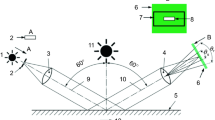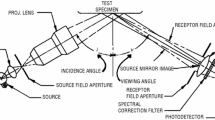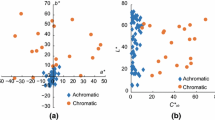Abstract
In the present study, attempts were made to clarify the existence of a correlation between visually perceived and instrumentally measured specular gloss of a series of achromatic samples. To this end, seven achromatic physical scales of specular gloss each consisting of 10 or 11 samples were prepared using lithographically printed black, white, and five in between gray papers. The samples were visually assessed and subsequently quantified in terms of a visually uniform color constant lightness scale, by a panel of 14 observers in an especially designed unidirectional light compartment at three illumination/observation geometries, namely 20°/20°, 60°/60°, and 85°/85°. Four statistical parameters were utilized to determine the correlation between visually perceived and instrumentally measured specular gloss. The results show that the instrumental 60°/60° geometry is capable of efficiently quantifying the equivalent specular gloss as perceived by a human observer. Surprisingly, it was also possible to accurately predict the visually quantified specular gloss both at the 20° and the 85° geometries by the aid of applying special linear relationships derived from the instrumentally measured specular gloss of the 60° geometry.










Similar content being viewed by others
References
ASTM Standard D 523-89, “Standard Test Method for Specular Gloss.” In: Annual Book of ASTM Standards, Vol. 06.01. ASTM International, West Conshohocken, PA, 1999
CIE 175:2006 Report, “A Framework for the Measurement of Visual Appearance.” Central Bureau of the International Commission on Illumination, CIE, Paris, 2006
Nadal, ME, Thompson, EA, “NIST Reference Goniophotometer for Specular Gloss Measurements.” J. Coat. Technol., 73 73–80 (2001)
ASTM Standard E284-05a, “Standard Terminology of Appearance.” In: Annual Book of ASTM Standards, Vol. 06.01. ASTM International, West Conshohocken, PA, 2006
Eugene, C, “Measurement of Total Visual Appearance: A CIE Challenge of Soft Metrology.” Presented at the 12th IMEKO TC1 & TC7 Joint Symposium on Man, Science and Measurement, Annecy, France, September 2008
Simonot, L, Hebert, M, Dupraz, D, “Goniocolorimetry: From Measurement to Representation in the CIELAB Color Space.” Color Res. Appl., 36 169–178 (2011)
Pointer, M, “Measuring Visual Appearance—A Framework for the Future.” NPL Report COAM 19, National Physical Laboratory, Middlesex, 2003
Ged, G, Obein, G, Silvestri, Z, Rohellec, JL, Viénot, F, “Recognizing Real Materials from Their Glossy Appearance.” J. Vision, 10 1–17 (2010)
Hunter, RS, Harold, RW, The Measurement of Appearance. Wiley, New York, 1987
Billmeyer, FW, O’Donnell, FXD, “Visual Gloss Scaling and Multidimensional Scaling Analysis of Painted Specimens.” Color Res. Appl., 12 315–326 (1987)
Harrison, VGW, Poulter, SRC, “Gloss Measurement of Papers—The Effect of Luminance Factor.” Br. J. Appl. Phys., 2 92–97 (1951)
Obein, G, Knoblauch, K, Chrisment, A, Viénot, F, “Perceptual Scaling of the Gloss of a One-Dimensional Series of Painted Black Samples.” Perception ECVP Abstract, 31 63 (2002)
Obein, G, Knoblauch, K, Viénot, F, “Difference Scaling of Gloss: Nonlinearity, Binocularity, and Constancy.” J. Vision, 4 711–720 (2004)
Obein, G, Pichereau, T, Harrar, M, Monot, A, Knoblauch, K, Viénot, F, “Does Binocular Vision Contribute to Gloss Perception.” J. Vision, 4 (11) 73 (2004)
Ji, W, Pointer, MR, Luo, MR, Dakin, J, “Gloss as an Aspect of the Measurement of Appearance.” J. Opt. Soc. Am. A, 23 22–33 (2006)
Leloup, FB, Pointer, MR, Dutré, P, Hanselaer, P, “Geometry of Illumination, Luminance Contrast, and Gloss Perception.” J. Opt. Soc. Am. A, 27 2046–2054 (2010)
Leloup, FB, Pointer, MR, Dutré, P, Hanselaer, P, “Luminance-Based Specular Gloss Characterization.” J. Opt. Soc. Am. A, 28 1322–1330 (2011)
Ferwerda, JA, Pellacini, F, Greenberg, DP, “A Psychophysically-Based Model of Surface Gloss Perception.” Proc. SPIE, 4299 291–301 (2001)
Obein, G, Vienot, F, Leroux, TR, “Bidirectional Reflectance Distribution Factor and Gloss Scales.” Proc. SPIE, 4299 279–290 (2001)
Leloup, FB, Pointer, MR, Dutré, P, Hanselaer, P, “Overall Gloss Evaluation in the Presence of Multiple Cues to Surface Glossiness.” J. Opt. Soc. Am. A, 29 1105–1114 (2012)
Leloup, FB, Obein, G, Pointer, MR, Hanselaer, P, “Toward the Soft Metrology of Surface Gloss: A Review.” Color Res. Appl., 39 559–570 (2014)
Westlund, HB, Meyer, GW, Hunt, FY, “The Role of Rendering in the Competence Project in Measurement Science for Optical Reflection and Scattering.” J. Res. Natl. Inst. Stand. Technol., 107 247–259 (2002)
Arney, JS, Ye, L, Banach, S, “Interpretation of Gloss Meter Measurements.” J. Imaging Sci. Technol., 50 567–571 (2006)
Seve, R, “Problems Connected with the Concept of Gloss.” Color Res. Appl., 18 241–252 (1993)
Nadal, ME, Thompson, EA, “New Primary Standard for Specular Gloss Measurements.” J. Coat. Technol., 72 61–66 (2000)
Ameri, F, Khalili, N, “Effect of Illumination/Observation Geometries on Visual Assessment of Certain Geometric Attributes of Automotive Paints.” J. Color Sci. Technol., 7 323–330 (2014), In Persian
Mirjalili, F, Moradian, S, Ameri, F, “A New Approach to Investigate Relationships Between Certain Instrumentally Measured Appearance Parameters and Their Visually Perceived Equivalents in the Automotive Industry.” J. Coat. Technol. Res., 11 (3) 341–350 (2014)
Mirjalili, F, Moradian, S, Ameri, F, “Derivation of an Instrumentally Based Geometric Appearance Index for the Automotive Industry.” J. Coat. Technol. Res., 11 (6) 853–864 (2014)
Kirchner, E, Dekker, N, “Performance Measures of Color-Difference Equations: Correlation Coefficient Versus Standardized Residual Sum of Squares.” J. Opt. Soc. Am. A, 28 841–1848 (2011)
García, PA, Huertas, R, Melgosa, M, Cui, G, “Measurement of the Relationship Between Perceived and Computed Color Differences.” J. Opt. Soc. Am. A, 24 1823–1829 (2007)
Huang, M, Cui, G, Melgosa, M, Sánchez-Marañón, M, Li, C, Luo, MR, Liu, H, “Power Functions Improving the Performance of Color-Difference Formulas.” Opt. Express, 23 597–610 (2015)
Huang, Z, Xu, H, Luo, MR, “Camera-Based Model to Predict the Total Difference Between Effect Coatings Under Directional Illumination.” Chin. Opt. Lett., 9 093301 (2011)
Huang, Z, Xu, H, Luo, MR, Cui, G, Feng, H, “Assessing Total Differences for Effective Samples Having Variations in Color, Coarseness, and Glint.” Chin. Opt. Lett., 8 717–720 (2010)
Torrance, KE, Sparrow, EM, “Theory for Off-Specular Reflection from Roughened Surfaces.” J. Opt. Soc. Am. A, 57 1105–1112 (1967)
Acknowledgment
The authors wish to thank Mr. Khosro Moradi at the Farabanafsh Chemical Co. and the Center of Excellence for Color Science and Technology for their support.
Author information
Authors and Affiliations
Corresponding author
Rights and permissions
About this article
Cite this article
Mirjalili, F., Moradian, S., Ameri, F. et al. Quantification and prediction of visually perceived specular gloss at three illumination/viewing geometries. J Coat Technol Res 13, 239–256 (2016). https://doi.org/10.1007/s11998-015-9756-2
Published:
Issue Date:
DOI: https://doi.org/10.1007/s11998-015-9756-2







